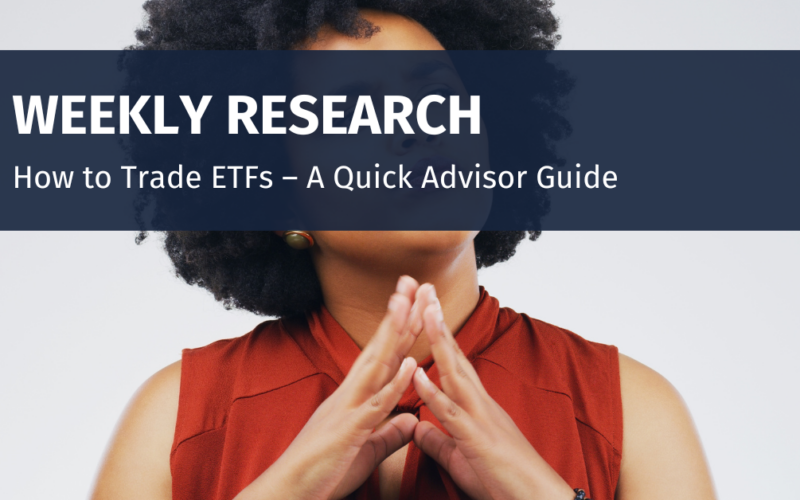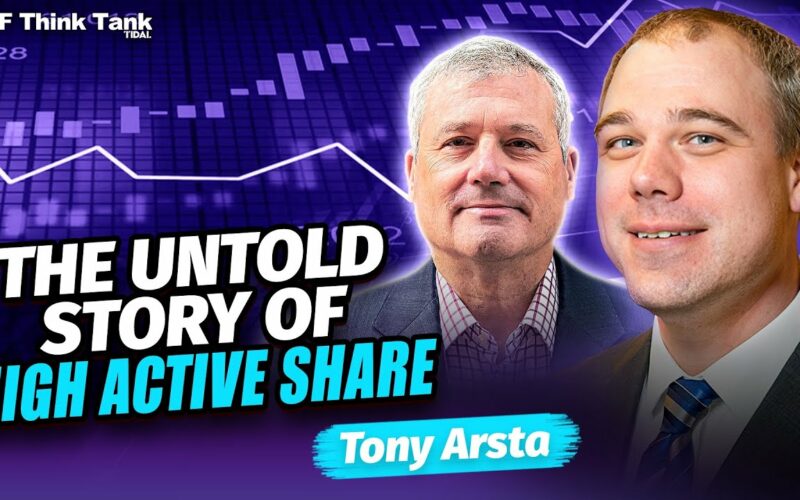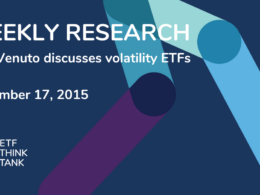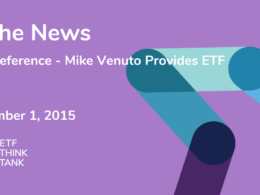Intraday trading – like that of any type of stock listed on an exchange – is one of the distinguishing characteristics of the ETF structure relative to other pooled investments such as mutual funds. You can get in and out of an ETF position all day long, every day.
But how do you do it best?
There’s a lot of educational material out there detailing the mechanics of ETF trading – each big issuer has its own take on it – but the key takeaway is this: ETF trading is easy and not something you have to do alone, but it requires some homework for the best execution.
With the help of Ryan Bader, Head of Operations and Risk at Tidal Financial Group, and ETF trader Chris Hempstead, Head of ETF and AP Portfolio Rebalance Trading at Mirae Asset Securities, we offer here a simple 5-step guide to trading an ETF.
- Set the expectations: Price, volume, liquidity.
Before you hit any button to buy or sell an ETF, make sure to do a little bit of homework on the data available to you.
First, figure out the price of that ETF, starting with the most recent net asset value (NAV) of that fund, a metric that’s published every evening on issuer websites and platforms.
Put that NAV into market context around the time you are looking to trade. What are market conditions? Who’s trading what? Say the ETF you are considering buying has a NAV of $25 but the market is up 1%, you shouldn’t expect to get shares of that ETF for $25. Get a sense of the action. Level set.
That level setting goes beyond price. It also pertains to volume – check who last traded that ETF, at what price, and where that ETF is being quoted at (bid-ask spread).
Finally, look at the liquidity displayed for that ETF – how much of your order can you get filled at that given time? For example, if you are looking to transact in 10,000 shares but displayed liquidity for that product is 1,000 shares, you may need help getting your trade done.
These data points are available on platforms like Schwab, Fidelity, LPL, etc., – as well as on issuer websites. Get comfortable with the data.
- Evaluate order type.
Everyone will tell you to never use a market order. They may be great at giving you an immediate sense of where the market’s at, and what liquidity is available (displayed or not), but market orders mean you get your trade executed at whatever price comes up.
If the market moves sharply in one direction or another, you may quickly find that to be a losing proposition. Instead, most recommend limit orders where you predefine a limit – a price range – in which to fill your order.
However, if you do want to use a market order, consider the Immediate-or-Cancel (IOC) order. With an IOC, any part of the trade that doesn’t get filled immediately gets canceled. For example, if you aim to buy 10,000 shares and only 1,000 are available, the remainder 9,000 would be canceled. That can prevent poor execution, especially if you find yourself being the biggest order for a given ETF.
- If trading in quantity, get to know the Request for Quote (RFQ) process.
Large orders or block trades require liquidity, but here’s the thing about liquidity – what’s displayed isn’t always what’s available.
Professional traders may not fully disclose available liquidity. Whether to prevent impacting the spread or to discreetly assess market opportunities, displayed liquidity isn’t always the full story. The Regulation NMS (National Market System) rule, which sets out to ensure that trades don’t get filled at prices worse than the National Best Bid and Offer (NBBO), allows that to happen.
As Hempstead puts it, folks are free to “passively float around” in the market with undisplayed shares on hand (liquidity) as long as they are navigating within the NBBO range for those shares. This so-called dark liquidity can be easily accessed to fill retail order flow – wholesalers do it often – and can help fill your large order too. A Request for Quote (RFQ) is a path to that.
For an RFQ, you must simply reach out to the trading desk you typically use at Schwab, Fidelity, Pershing, LPL, Envestnet, etc., or to the capital markets desk at that ETF’s issuer. They are at your disposal looking for an opportunity to help you trade ETFs. Give them a call. Ask for a RFQ for your large trade.
What happens next is this: that trade desk will check with anywhere from 3 to 6 liquidity providers (firms like Jane Street, Susquehana, Old Mission, etc) to find out who can best fill your trading order at what price. At this point, you can either give them carte blanche to fill that RFQ order, or you can ask for a RFQ without execution if you want to first see the terms of the deal before pushing the buy/sell button.
Here, traders are interacting with market makers on your behalf looking for the best execution for you.
“The RFQ is an incredibly useful tool for advisors. It’s very advanced, automated and incredibly reliable for individuals, advisors and institutions who are looking for block liquidity that’s significantly more than what they might find in the market on their own,” Hempstead says.
- Complexity for you means complexity for everyone.
When you are transacting in ETFs that are not vanilla – think funds that rely on illiquid underlying options or derivatives, or funds tapping into illiquid foreign securities – there are a few things to remember.
Number 1 is the simple fact that these complex ETFs are enabling you to access strategies and pockets of the market you’d probably struggle to replicate on your own. This is important because it goes back to level setting. These types of funds may trade at wider spreads, may have low liquidity, and may cost more to transact in than others, but they are still a powerful tool in your kit of problem-solving solutions.
With that in mind, consider accessing your trade desk, which can work directly with market makers. Navigating in illiquid securities can be tricky – especially in large sizes – and you may impact prices with a big order. But market makers make markets for a living, even in illiquid segments. They are more likely to find the liquidity you seek at better prices than anything you may get on your own.
Keep in mind that when transacting in complexity, transaction costs can add up, Bader says.
“The sell-side looks at implied liquidity, and esoteric products that aren’t just trading equities are going to have a different liquidity profile. If you are buying a futures-based fund, you are likely going to see deterioration from the roll tied to the expense of trading the underlying. If you are transacting in a leveraged fund, you are talking about adding swaps on futures, and execution costs go up, eating at your fund. You don’t see a line in your fund for cost to finance the swaps, or the cost to roll your futures contracts, but it’s part of the trading and gets expressed in the fund’s expenses,” Bader says.
Transacting in complexity can get pricey, and the more you spend, the less you keep. Make sure you understand what you are buying and are comfortable with the risks.
- Take to heart the conventional wisdom that says you should avoid trading at the opening and at the closing.
This isn’t a hard rule. In fact, while most say openings can be dicey for non-professional traders as the market digests overnight news, opinions are divided when it comes to trading at the close. Some say avoid it, other say closings may bring ample liquidity at a times.
Either way, these are typically volatile times to trade (within, say, 15 minutes after opening and before closing), so consider avoiding them if you can.
“As an advisor, if you have to trade at the open, be aggressive – bid low, offer high, and if you get it done, you’re getting it done at someone else’s expense,” Hempstead says. “Try not to be a taker of liquidity at the opening – it’s not a good time to go shopping.”
Ready, Set, Go
Before you trade an ETF, look at the data available to you, take the market’s pulse and see where bids and offers live. Set your expectations of what consists of a good price and good execution, while understanding the strategy you are transacting in.
When in doubt, stop and ask questions. Rely on the traders and market makers who are out there to help you get the best result for you and your client. The ETF industry has a lot of plumbing in place designed to help everyone involved succeed – make use of those resources.
As Hempstead puts it, “These are core, best practice behaviors that don’t take a lot of time. Most advisors don’t have a gun to their head saying ‘trade right now’, and often times they forget that there are capital market teams available to them at every issuer. Slow it down and talk through it. You will have a much better experience.”
Disclosures
All investments involve risk, including possible loss of principal.
The material provided here is for informational purposes only and should not be considered an individualized recommendation or personalized investment advice. The investment strategies mentioned here may not be suitable for everyone. Each investor needs to review an investment strategy for his or her own particular situation before making any investment decision.
All expressions of opinion are subject to change without notice in reaction to shifting market conditions. Data contained herein from third-party providers is obtained from what are considered reliable sources. However, its accuracy, completeness, or reliability cannot be guaranteed.
Examples provided are for illustrative purposes only and not intended to be reflective of results you can expect to achieve.
The value of investments and the income from them can go down as well as up and investors may not get back the amounts originally invested, and can be affected by changes in interest rates, exchange rates, general market conditions, political, social, and economic developments, and other variable factors. Investment involves risks including but not limited to, possible delays in payments and loss of income or capital. Neither Tidal nor any of its affiliates guarantees any rate of return or the return of capital invested. This commentary material is available for informational purposes only and nothing herein constitutes an offer to sell or a solicitation of an offer to buy any security and nothing herein should be construed as such. All investment strategies and investments involve risk of loss, including the possible loss of all amounts invested, and nothing herein should be construed as a guarantee of any specific outcome or profit. While we have gathered the information presented herein from sources that we believe to be reliable, we cannot guarantee the accuracy or completeness of the information presented and the information presented should not be relied upon as such. Any opinions expressed herein are our opinions and are current only as of the date of distribution, and are subject to change without notice. We disclaim any obligation to provide revised opinions in the event of changed circumstances.
The information in this material is confidential and proprietary and may not be used other than by the intended user. Neither Tidal nor its affiliates or any of their officers or employees of Tidal accepts any liability whatsoever for any loss arising from any use of this material or its contents. This material may not be reproduced, distributed, or published without prior written permission from Tidal. Distribution of this material may be restricted in certain jurisdictions. Any persons coming into possession of this material should seek advice for details of and observe such restrictions (if any).












